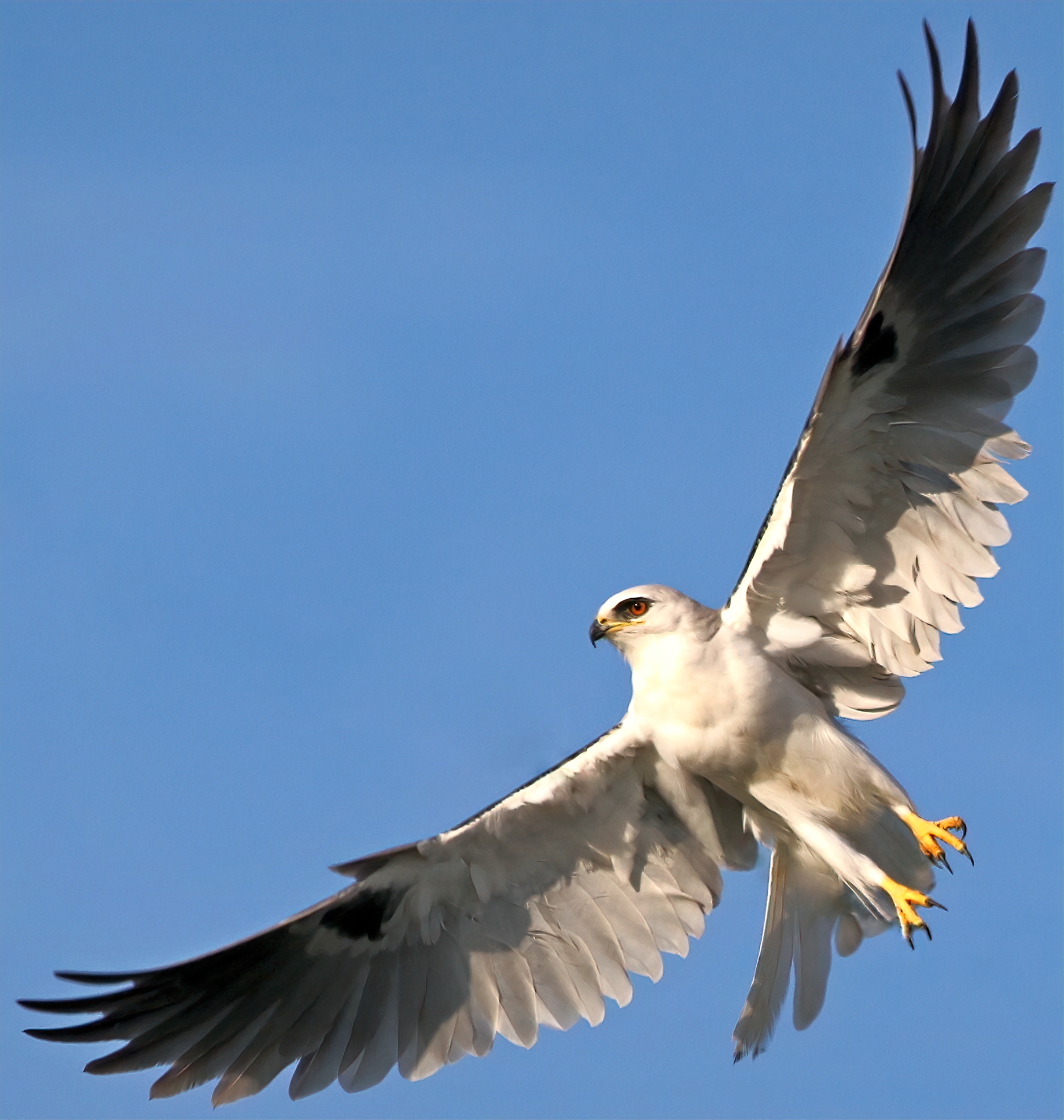by M. Kathy Raines

Thinking they were seagulls, I once paid them little mind. Then a whitish gray “gull”, like a fluttering, suspended marionette, hovered for minutes, legs a-dangle, beating its wings mightily—a remarkable spectacle amidst swirls of pearly clouds.
Now I frequently watch these raptors, white-tailed kites, as they perch or hover over fields, empty lots and roadways. In fact, their hovering—fluttering in place as they face the wind, searching for prey—is called “kiting” or “helicoptering.”

Perched on a branch or pole, a white-tailed kite, often with a companion, gazes, cat-like, from burning red eyes. Set within black teardrop-shaped patches, these eyes, with the kite’s tiny, hooked beak, form a small, triangular face. Smartly dressed in tidy, cloud-tinted feathers, this handsome, medium-sized raptor sports long black shoulder patches and white underparts.
The white-tailed kite (Elanus leucurus) typically eats small rodents, its apparent favorite being the hispid cotton rat, but also some birds, insects and lizards. Hovering at heights of from 20-72 feet, it parachutes down upon prey, its wings in an acute ‘V’ and its yellow legs extended.
Occasionally, the kite must ward off a thief—a caracara, northern harrier or red-tailed hawk. A raptor may seize its prey only to see the plucky kite, in a pitched struggle, perhaps joined by an ally, snatch it back. The kite dines at its perch, though it may eat small prey during flight.
White-tailed kites, whose breeding populations appear to be expanding, thrive in grasslands and savannas of southern and eastern Texas, Florida and much of the Southwest. Populations fluctuate with available prey and water, and kites avoid sites that undergo hard freezes. Though not true migrants, these opportunistic kites do wander.
In the past century, white-tailed kites have rebounded from near devastation. In fact, their scarcity in the latter centuries prompted ornithologists to predict their doom. They died primarily at the hands of hunters, who mistakenly believed these unsuspicious kites fed on prized game birds. Also, Victorian egg collectors—practicing a misguided hobby now punishable by hefty fines—coveted their handsome, brown-flecked eggs.
White-tailed kites employ an array of vocalizations: a guttural, repeated “grrrkkk” when repelling an intruder; a staccato, low “er-er-er-er” or cluck while capturing prey; a “kewt”, “keep” or “kewp” of adult pairs or adults talking with young; a low raspy cry or osprey-like whistle when alarmed.
During courtship in winter and spring, white-tailed kites engage in flutter flights, with wings flapping at shallow angles with short, seemingly vibrating strokes with legs dangling. A male may offer the female food before she lays eggs, while she, in flight, meets him, sometimes flying upside down to grasp it. Pairs often remain together throughout the year.
Both males and females, during a weeks-long process, build a platform of twigs and grass in trees, yucca or shrubs. The female incubates the eggs, leaving the nest only to grab prey from the male in an aerial or side-to-side delivery. Chicks, coated with tan or yellowish down, emerge after from 30-32 days. They fly at about four or five weeks. Adult plumage and eye color—eyes of immature birds are brownish, rather than red—appear in a few months.
Each sighting of these extraordinary birds brings fresh awe. Exiting my car, my brain clicking off tasks, I spot a pair of white-tailed kites soaring and hovering above a stubbly, trash-strewn lot, and I am transported. Frantic to-do lists dissolve. I watch the dance.

